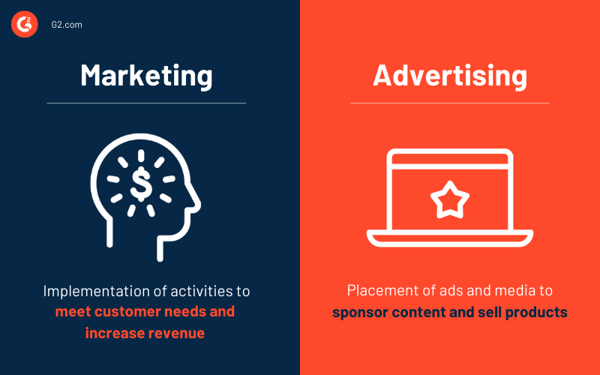June 16, 2022
.jpg?width=400&height=150&name=G2Headshots_Aayushi_Sanghavi_ZOE1415-Edit%20(1).jpg) by Aayushi Sanghavi / June 16, 2022
by Aayushi Sanghavi / June 16, 2022

This is not a twinning moment.
Marketing and advertising, although related, are very different from each other. Although both business activities strive to refine the brand image and increase sales, advertising is a subset of marketing and works toward different goals.
Technology such as marketing automation software and cross-channel advertising software automates marketing and ad campaigns to collect prospect information, create targeted campaigns, and report performance. Effective marketing and advertising activities help businesses reach higher conversions and lead generation, as well as manage customer relationships.
Marketing requires exploring, creating, and delivering value to meet customer needs while maximizing revenue. Advertising is a part of marketing communication that includes sponsored messages to sell products, services, concepts, or ideas.
Although we hear people talk about marketing and advertising interchangeably, it’s important to remember that the latter is a part of the greater marketing umbrella. So yes, they are entirely different processes but are related and can be grouped together. Like cousins, ya know?
Everyone raise your hands for your favorite corporate buzzword!
While a majority of people have no problem explaining what marketing encompasses, it can get a little winding to define it to the point. So let’s do a little refresh.
Marketing is defined as any business practice that helps identify and predict customer demands while creating and delivering product or service value. Successful marketing requires researching target audiences, market conditions, and product opportunities.
The process lies at the heart of effective product development and guides a company’s value propositions and selling points. It is therefore not wrong to say that marketing has a big impact on a business's bottom line.
Marketing is like a jack of all trades – it can do many different things for businesses based on their specific needs. All sectors employ marketing strategies in one way or another (print, digital, face-to-face, door-to-door) to grow their customer base, promote goods, and increase revenue.
One of the biggest facets of marketing is capturing audience attention. Most marketing strategies work to create a memorable experience for the customer to maintain top-of-mind awareness. This helps develop a brand reputation, one that is tied to quality, value delivery, and customer satisfaction.
Paying attention to the direct and indirect experiences customer have with a company is directly linked to reputation management. Businesses around the world have now understood the importance of a brand’s public perception and how it affects revenue.
In an ideal world, all businesses understand the importance of aligning sales and marketing efforts to increase the number of available revenue options. While sales are and should be the priority of any company, revenue collected through marketing activities increases profits primarily by targeting customers based on their preferences and purchase histories.
Marketers strive to boost revenue strategically through promotions, campaigns, business messaging, and price reduction. By working closely with sales, marketing teams directly attribute to lead generation, conversion, and retention to achieve shared business goals.
I’ve said this once and I’ll say it again: businesses that focus on customer engagement are the ones that are winning.
When it comes to customer engagement, marketing helps refine customer communication by keeping the conversation relevant. Investing in engaging customers promotes products while providing consumers with important information and a sense of belonging.
Customer engagement forms part of the overall customer experience and is essential to ensure that customers know what the company is and why they should buy their products or services.
When users have the information they need to make a purchase decision, they feel more confident to take the leap and convert.
Leveraging the principles of marketing is a sure-shot way of making customers feel like they understand the benefits of buying a product or service. Simply put, the more informed customers are, the more likely they are to convert and consequently, boost company sales.
Every business works toward specific goals and objectives. Goal setting is most often the first step in creating plans, teams, and workflows.
Having dedicated marketing strategies in place leads to a clear identification of what targets the marketing team should achieve. These include increasing brand awareness, maintaining reputation, reaching more customers, and contributing towards marketing business revenue.
Developing and implementing a successful marketing strategy looks different for different companies. The first step is identifying marketing goals and target audiences. Typically, this information is included in an organization’s business plan and guides the marketing objectives and activities.
Even though every business has its own way of formulating marketing strategies, there are a few elements that should be considered by all marketers.
A marketing strategy, like any business strategy, must be based on specific knowledge and research. It’s essential that marketers use this information to align their efforts with the company’s mission, vision, and culture.
Market orientation is key to understanding whether the business must orient its strategy towards the product, sales, or overall marketing activities. The various market orientation perspectives include market intelligence, decision-making perspective, strategic perspective, cultural and behavioral perspective, and customer orientation perspective.
Any factor that can have an impact on a company’s marketing strategy should be considered as part of the marketing environment. This includes both micro and macro environments such as the operating country’s economic environment, the business’ competitive environment, the technological environment, as well as the political and social environment.
The difference between any ol’ business and a great one is the attention to detail it gives to market and user research. Focusing on the characteristics of a customer, building user personas, and studying different user segments helps to gauge which audiences will respond effectively.
Additionally, collecting geographic and demographic data of target customers makes it easier to market products and services.
Any of you who have ever looked up the basics of marketing must be familiar with this concept.
The marketing mix serves as a decision-making tool for a company’s marketing strategy. It refers to the variables a business chooses to influence buyer response and behavior. These elements work together with other initiatives to establish a brand and sync with the marketing plan and advertising strategy.
The seven Ps of marketing have retained their importance and relevance even with all the changes in the marketing world:
I might regret this later, but take a minute away from reading this article and think back on the most memorable ad campaigns you can think of. I’ll go first: Open happiness by Coca-Cola!
Advertising is the process of making audiences aware of products and services by producing paid advertisements that contain brand messages. Advertising campaigns are intended to promote goods and establish a strong brand image to guarantee product recall and increase sales.
A key element of advertising is that it establishes a one-way communication channel to promote non-personal brand messages. Another factor that distinguishes advertising from marketing is that the content is completely controlled by companies.
Successful advertising campaigns help consumers make rational purchase decisions and empower businesses to expand their market.
If you’ve been following through (which I hope you have), you may have a better understanding of what marketing and advertising are as standalone concepts.
While marketing is a broader business activity and can directly affect an organization’s bottom line, advertising plays an integral role in brand positioning, product placement, and enticing new customers to increase sales.

Marketing and advertising have different business functions and goals even though the main, shared objective is making the business profitable.
Marketing is focused on five central activities.
Advertising has a narrow focus and involves processes like:
Since marketing and advertising work toward achieving different goals, there is a difference in how they meet those objectives.
Remember the days when marketing referred to receiving product catalogs in your mail and being delighted at their arrival? The good ol’ days. Modern marketing strategies have evolved from humble print efforts into the digital and e-commerce era.
An advertising campaign aims to spread brand awareness about the company and its products to acquire customers and generate more sales with product launches and promotions.
An advertising campaign must be tailored to business objectives, target audience, and customers’ wants and needs. Knowing where your customers are most likely to be exposed to ads is essential to campaign success.
Every business activity is dependent on decided analytics and measurements. Implementing marketing analytics tools simplifies and optimizes overall marketing strategies to ensure long-term success.
The five main metrics to measure against campaigns for marketing teams are:
The five key metrics to use as a guiding force for advertisers are ad reach and impressions, return on ad spend, engagement, and conversion rates.
Five essential metrics to measure the success of advertising campaigns:
As is evident by now, advertising is essentially a part of marketing activities.
While marketing prepares a product for the market, advertising is responsible for increasing product visibility within the marketplace.
Marketing involves several stakeholders and is a broad business function, while advertising has a narrower focus and works on producing effective communications. They leverage data and research collected by marketers to promote the brand through creative and compelling messages.
Marketing and advertising are integral organizational functions. Collectively, they can improve customer satisfaction, target new prospects, and strengthen brand value.
Regardless of the type of campaign employed, it’s important to research and have the necessary information about both activities to maximize their business impact.
Understanding marketing and advertising is a great step toward improving the overall customer experience management process. Learn more about the importance of customer experience and its impact.
Aayushi Sanghavi is a Campaign Coordinator at G2 for the Content and SEO teams at G2 and is exploring her interests in project management and process optimization. Previously, she has written for the Customer Service and Tech Verticals space. In her free time, she volunteers at animal shelters, dances, or attempts to learn a new language.
Think how annoying it'll be to search for running shoes and get results for Texas colleges or...
 by Daniella Alscher
by Daniella Alscher
Let’s talk financials — specifically, the two numbers every business owner, investor, and CFO...
 by Mary Hart
by Mary Hart
In this post, we’ll break down the difference between PPC and CPC, describe how they work and...
 by Kevin Kapezi
by Kevin Kapezi
Think how annoying it'll be to search for running shoes and get results for Texas colleges or...
 by Daniella Alscher
by Daniella Alscher
Let’s talk financials — specifically, the two numbers every business owner, investor, and CFO...
 by Mary Hart
by Mary Hart


